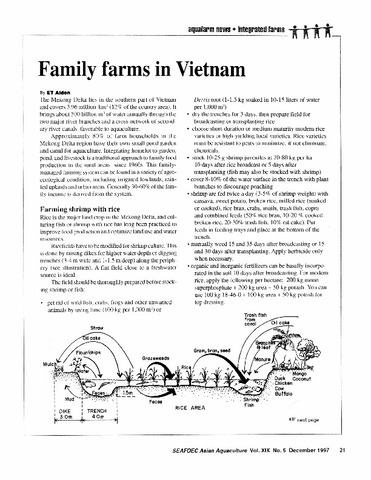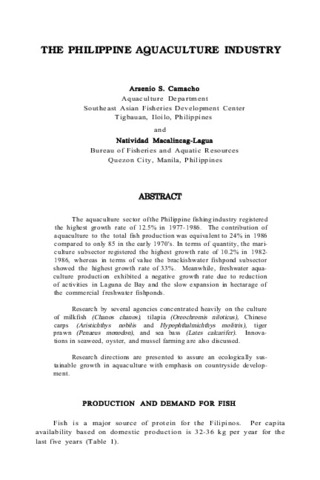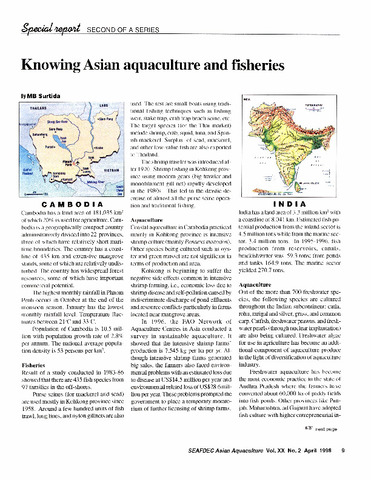| dc.contributor.author | Toledo, Joebert D. | |
| dc.contributor.editor | Liao, I Chiu | |
| dc.contributor.editor | Leaño, Eduardo M. | |
| dc.date.accessioned | 2015-04-24T06:00:24Z | |
| dc.date.available | 2015-04-24T06:00:24Z | |
| dc.date.issued | 2008 | |
| dc.identifier.citation | Toledo, J. D. (2008). Grouper aquaculture R&D in the Philippines. In I. C. Liao & E. M. Leaño (Eds.), The Aquaculture of Groupers (pp. 79-93). Quezon City, Philippines; Baton Rouge, LA, USA; Keelung, Taiwan: Asian Fisheries Society; World Aquaculture Society; The Fisheries Society of Taiwan; National Taiwan Ocean University. | en |
| dc.identifier.isbn | 9789860143317 | |
| dc.identifier.uri | http://hdl.handle.net/10862/2194 | |
| dc.description.abstract | Culture of groupers in ponds and floating net cages has been practiced for many years in the Philippines. Unsustainable culture practices such as dependence on wild caught seeds, use of trash fish, use of high stocking densities, and unregulated expansion and proliferation of fish cages, have led to the "boom and bust" cycle of grouper aquaculture in the Philippines. The drastic decrease in grouper aquaculture production in the late 90's was mainly attributed to environmental deterioration and diseases outbreaks. To sustain grouper production, research on the breeding, seed production and culture of groupers started in the mid 1980s. As a regional inter-government R&D organization, the Aquaculture Department of the Southeast Asian Fisheries Development Center (SEAFDEC/AQD) followed the recommendations of the 1987 Seminar-Workshop on Aquaculture Development in Southeast Asia on grouper R&D. Research activities initially focused on market survey of grouper species in the Philippines and Southeast Asia, assessment of fry and availability in traditional fishing grounds, and development of broodstock management techniques. Following the spontaneous spawning of Epinephelus coioides in concrete tanks and floating net cages in 1990's, protocols for the seed production of milkfish and sea bass were adapted and modified. Parallel studies to determine sustainable culture techniques in ponds and net cages were conducted. Studies on the nutritional requirements of grouper at various developmental stages were done to reduce dependence on live prey organisms and trash fish as feeds. Research geared towards health management started in the in late 90's to early 2000's. Prospects for grouper aquaculture are discussed in the light of recent advances in grouper R&D and the Government of the Philippines initiatives to increase fish production by mariculture. | en |
| dc.language.iso | en | en |
| dc.publisher | Asian Fisheries Society | en |
| dc.publisher | World Aquaculture Society | en |
| dc.publisher | The Fisheries Society of Taiwan | en |
| dc.publisher | National Taiwan Ocean University | en |
| dc.subject | Groupers | en |
| dc.subject | Epinephelus coioides | |
| dc.title | Grouper aquaculture R&D in the Philippines | en |
| dc.type | Book chapter | en |
| dc.citation.spage | 79 | |
| dc.citation.epage | 93 | |
| dc.subject.asfa | aquaculture development | en |
| dc.subject.asfa | breeding stock | en |
| dc.subject.asfa | seed production | en |
| dc.subject.asfa | fish culture | en |
| dc.subject.asfa | Marine aquaculture | en |
| dc.citation.bookTitle | The Aquaculture of Groupers | en |



